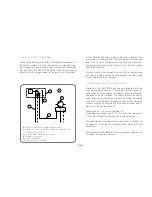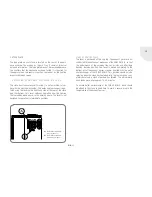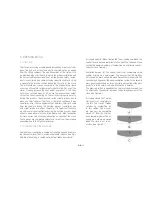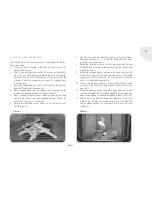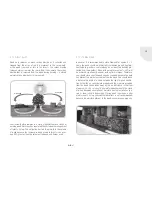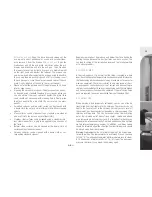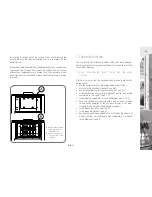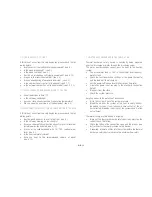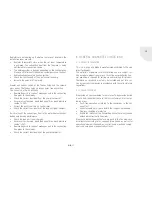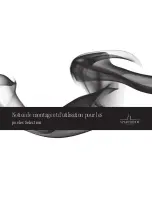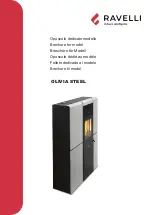
GB
42
5.2 YOUR CONTRIBUTION TO ENVIRONMENTAL PROTECTION
Whether your stove burns in an environmentally friendly way is de-
pendent to a large degree on how it is operated and which fuel is
used. The following advice should help you to operate your stove in
an environmentally friendly way:
• As far as possible, do not use any resinous wood (spruce, pine,
fir). These types of wood cause sooting of the stove panel to oc-
cur quicker and there is an increase in flying sparks. Therefore,
please only use hardwoods (birch, beech, oak, wood from fruit
trees) for safety reasons.
• Adjust the volume of wood used to the relevant heating require-
ments.
You can check whether a clean and low-emission burning process
is taking place in your stove as follows:
• The ash should be white. A darker colour indicates residual
charcoal and incomplete burning.
• The exhaust gases from the chimney pot should be as clear as
possible (the clearer the exhaust gases, the better the burning
process).
• The firebox lining in your stove is light and not sooted after
burning.
Please note:
The fireplace may not be used as a waste incinerator!
Furthermore, this stove is designed for temporary burning. Perma-
nent operation can also not be achieved due to the extraction of
combustion air and is not permitted!
6. CLEANING AND CARE
The stove may only be cleaned in a cold state. Please note that
cleaning can lead to soiling of the installation room and your cloth-
ing. We recommend that you protect the area around the opening
to the fireplace from soiling with a plastic sheet or a blanket and
that you wear work clothes. All dismantled components must be
installed again after cleaning.
6.1 CLEANING THE FIREBOX / OUTER CASING
• The stove, the firebox, the smoke collection chamber with the
exhaust control system, the combustion air system and the ex-
haust flue pipes to the chimney must be inspected for deposits
and, if necessary, cleaned at regular intervals on a yearly basis
and also perhaps during and after the heating season and af-
ter the chimney has been cleaned (consult your stove dealer
or chimney sweep in your district). Remove any deposits using
a hand brush and/or an ash vacuum cleaner (from specialist
dealer). The chimney should be cleaned at regular intervals by
a chimney sweep! Furthermore, the stove should be inspected
each year by a specialist.
• Exhaust gas control system: Additional exhaust gas deflec-
tors and convection pipes can be found above the fireplace
and in the exhaust gas collector. These components should be
cleaned regularly. The bufferplates must be removed in order
to complete this task. They need to be lifted, then twisted and
can be removed through the firebox in this way. The deposits
on the bufferplates and the convection pipes can be cleaned
off easily using a hand brush.
• Ash removal: Your stove is suitable for burning dry wood, which
burns best in its own ash. If you nevertheless want to remove
the ash from the firebox:
Summary of Contents for Passo L
Page 2: ......
Page 3: ...Montage und Betriebsanleitung Kaminöfen Selection ...
Page 54: ...D 52 RAUM FÜR IHRE NOTIZEN ...
Page 55: ...Installation and Operating Instructions for Stoves Selection ...
Page 106: ...GB 52 SPACE FOR YOUR NOTES ...
Page 107: ...Notice de montage et d utilisation pour les poeles Selection ...
Page 158: ...F 52 VOS NOTES ...
Page 159: ...Istruzioni di montaggio e d uso per stufe camino Selection ...
Page 210: ...SPAZIO PER I VOSTRI APPUNTI IT 52 ...
Page 211: ...Instrucciones de montaje y uso de las estufas de le a Selection ...
Page 262: ...ES 52 ESPACIO PARA SUS APUNTES ...
Page 263: ...Montage en gebruikshandleiding Kachels Selection ...
Page 314: ...NL 52 RUIMTE VOOR AANTEKENINGEN ...
Page 315: ...Instrukcja montażu i obsługi pieców kominkowych Selection ...
Page 366: ...PL 52 MIEJSCE NA PAŃSTWA NOTATKI ...
Page 367: ...Руководство по монтажу и эксплуатации печей каминов Selection ...
Page 418: ...РУС 52 МЕСТО ДЛЯ ВАШИ ЗАПИСЕЙ И ПОМЕТОК ...
Page 419: ......



